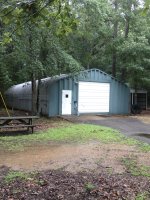I never heard of a Texas County with any sort of Building Code. Each city has their own rules for building and most fallow the Southern Building Code for residential home construction. The bigger cities will add their own stuff to what they want, and that can be significant in areas where the weather can be more extreme.
Electrical Code is National, but there is no enforcement outside of city limits.
Septic is National and there are inspectors that check rural properties, but it's so undermanned and underfunded that there is usually one person for several counties, and they spend all their time driving long distances to investigate the worse complaints.
On your road, the most cost effective way to do it yourself is to first build it up with clean dirt. Get it into shape by adding material where you need it. Nothing is going to be cheaper then dirt, or more effective at creating a base. Once you have the dirt work done and compacted, then you can add gravel or crushed concrete. You need at least 4 inches for it to lock together and shed water. If it's thinner, it will move on you and quickly develop pot holes. I've found that crushed concrete gives a much better, more solid road then crushed limestone. There is a lot of variation in limestone used for roads here in Texas. Some is harder then others. All of the limestone used in my area, Tyler, comes from Terrell. It's a soft limestone, so it wears out fairly quickly. The concrete is extremely hard, and it's night and day better then the limestone that I started out with.
For your building, be sure to draw it out and add furniture and equipment to the drawing. Your building isn't very big, so space needs to be figured out. Don't forget to include the thickness of the walls to the layout.
A wood pole barn is the cheapest to build. It is a bare bones building that does not require concrete or a lot of prep work.
A metal building will cost a lot more for the same square footage, but it's big advantage is how far you can span the roof without any supports. It will require concrete that has to have footings designed for the weight of the metal posts that hold the building up. This takes some knowledge in what you are doing beforehand because the footings will need to be perfect for the metal posts. They either get welded to a plate embedded in the concrete, or bolts have to be placed in the concrete so they line up with the posts. Drilling into the concrete to attach the posts might work for a smaller building, but it's not ideal.
If you are pouring concrete for the floor, then I feel stick construction is going to be the fastest, most cost effective method of building. Pole barns and metal buildings lack anything to have a finished internal wall, so you have to spend the money of studs anyway to finish off the interior. You will also have to have trusses, or rafters 2 feet apart for a ceiling, so that negates the cost savings of a pole barn or metal building. With stick framing, everything is simple and straight forward. If you go with pole building, or metal building methods, then you are converting, modifying and adding materials to make those types of buildings more like a stick framed building, which will cost more money and time.
If a pole building or metal building is already built, then converting them are easy, but if you are starting from scratch, then stick building is going to be the most cost effective.
